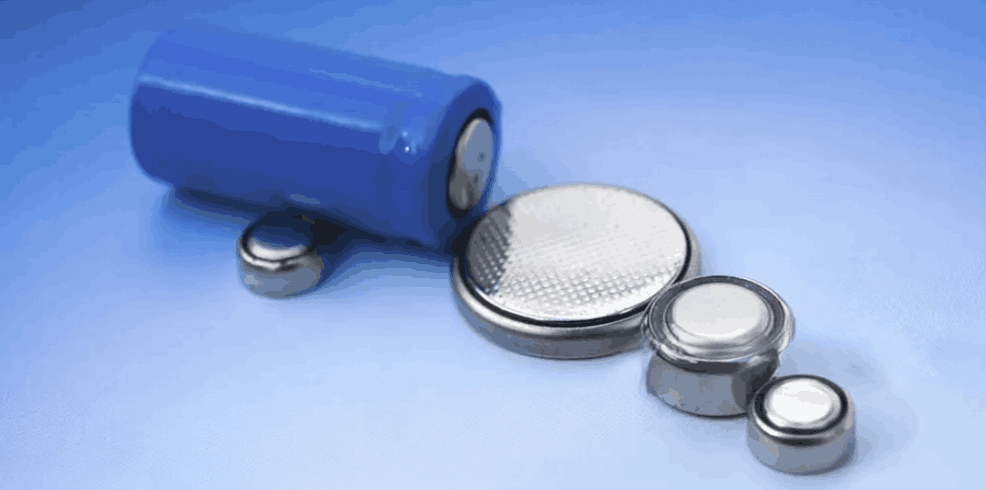Electrode Materials:
Cathode: Manganese dioxide (MnO₂) with a layered structure, enabling charge transfer through lithium-ion intercalation.
Anode: Metallic lithium (Li), which has a theoretical specific capacity of up to 3860 mAh/g and serves as the main energy source.
Electrolyte: Organic lithium salts (e.g., LiClO₄) dissolved in carbonate solvents, which facilitate ion conduction but are non-rechargeable.
Operating Characteristics:
Supports only single-use discharge. The reaction is:
Li+MnO2→LiMnO2
Once energy is released, the battery cannot be recharged.
Internal resistance increases progressively during discharge, with a sharp voltage drop at the end of life—suitable for low-power, one-time-use applications.
Electrode Materials:
Cathode Options:
Lithium Cobalt Oxide (LiCoO₂): High energy density (274 mAh/g), widely used in consumer electronics like smartphones.
Lithium Iron Phosphate (LiFePO₄, LFP): High thermal stability (>500°C), long cycle life (>3000 cycles), dominant in power battery applications.
Lithium Manganese Oxide (LiMn₂O₄, LMO): Cost-effective and heat-resistant, suitable for power tools.
Anode Options:
Graphite: Theoretical capacity of 372 mAh/g, enables reversible lithium-ion intercalation with >95% reversibility.
Silicon-based Anode (Emerging Technology): Theoretical capacity of 4200 mAh/g, but volume expansion (>300%) remains a challenge.
Electrolyte: Lithium hexafluorophosphate (LiPF₆) dissolved in a mixed solvent system (EC + DMC + EMC), supporting reversible lithium-ion migration.
Operating Characteristics:
Supports multiple charge-discharge cycles.
Equipped with a Battery Management System (BMS) that offers protection against overcharge, over-discharge, and overcurrent.
Dimension | Lithium Battery (CR2032 Typical Value) | Lithium-ion Battery (Industry Average) | Difference Analysis |
Nominal Voltage | 3.0V | 3.2V (LFP) / 3.7V (NCM) | Lithium-ion batteries have higher voltage platforms, better suited for high-power devices |
Energy Density | 550 Wh/L | 600–900 Wh/L | Lithium-ion offers 30%–60% higher endurance performance |
Cycle Life | 1 time (non-rechargeable) | 300–3000 cycles (depending on material) | Lithium-ion is more suitable for long-term and frequent use |
Operating Temperature | -40°C to 60°C | -30°C to 60°C (wide-temperature versions: -40°C to 85°C) | Lithium-ion has stronger adaptability to high/low temperatures |
Self-Discharge Rate | <1% / year | <3% / month | Lithium batteries are better suited for long-term storage scenarios |
Safety Design | No protection circuit | Built-in BMS protection | Lithium-ion requires additional protection for safety assurance |
Comparative Analysis of Lithium Manganese Dioxide (Li-MnO₂) and Lithium-ion (Li-ion) Battery Technologies
Although both Lithium Manganese Dioxide (Li-MnO₂) and Lithium-ion (Li-ion) batteries belong to the lithium battery family, they differ significantly in chemical structure, performance, and application scenarios. This article analyzes their technical principles, key parameters, and real-world applications to provide professional reference for device selection.
1.Initial Cost vs. Long-term Investment
Li-MnO₂ Battery:
As a primary (non-rechargeable) battery, it has a lower manufacturing cost and is relatively inexpensive—ideal for low-power devices.
Li-ion Battery:
Though it requires a higher initial investment, it supports multiple charge-discharge cycles, resulting in a lower total cost of ownership over time. It’s better suited for high-energy-demand applications.
2. Lifespan Factors and Selection Recommendations
Li-MnO₂ Battery Lifespan Constraints:
Limited by its non-rechargeable design. Lifespan is determined solely by discharge duration. For example, a CR123A cell in a smart water meter can last up to 10 years but is unsuitable for high-frequency use.
Typical Use Cases: Remote controls (replaced once or twice per year), emergency lights (replaced every 5 years).
Li-ion Battery Lifespan Advantages:
LiFePO₄ (LFP): Cycle life exceeds 3000 cycles. Assuming one cycle per day, it can last over 8 years.
LiPo (Lithium Polymer): Cycle life ≥500 times, suitable for wearable devices with 2–3 year product lifecycles.
Typical Use Cases:
Consumer electronics such as smartphone batteries (about 500 cycles, ~2 years).
Energy storage systems using LiFePO₄ (up to 2000 cycles, 10 years maintenance-free).
1. Li-MnO₂ Battery: Best for Static, Low Power Scenarios
Typical Applications:
Industrial Instrumentation: Built-in power for smart water/gas meters; single-use lifespan exceeds 10 years. Common models include CR123A (3V/1500mAh).
Security Devices: Backup power for smoke detectors and emergency locators, benefiting from ultra-low self-discharge (<0.3% per month).
Selection Notes: Ideal for “one-time use, low power consumption, long shelf life” scenarios, such as remote controls and digital scales.
2. Li-ion Battery: Core Power Source for Dynamic, High-Energy Scenarios
Typical Applications:
Consumer Electronics: Smartphones (LiCoO₂), smartwatches (LiPo), supporting fast charging and long cycle life.
Power Batteries: Electric vehicles (LiFePO₄) with >500 km range and cycle life >2000 times.
Industrial Equipment: AGV warehouse robots using 38.4V/100Ah LiFePO₄ batteries, supporting 24/7 operation and -30°C cold start.
Energy Storage Systems: Home storage batteries (10kWh LiFePO₄), with 95% charge/discharge efficiency, compatible with solar energy storage.
Selection Notes: Suitable for scenarios involving “frequent charging/discharging, high energy demand, and long lifespan,” such as 3C devices, EVs, and smart hardware.
1. Li-MnO₂: Material Improvements for Extended Performance
Composite Cathode Technology: Combining manganese dioxide with carbon nanotubes (CNT) improves conductivity, raising the discharge plateau from 2.8V to 3.0V.
Extreme Environment Adaptation: Military-grade products using glass sealing enable full-temperature operation from -55°C to 85°C, suitable for aerospace applications.
2. Li-ion: Performance Breakthroughs and Ecosystem Innovation
Solid-State Batteries: Using sulfide-based electrolytes, energy density exceeds 500 Wh/kg. Mass production is expected by 2030. Solves leakage and dendrite issues.
Recycling Systems: The EU’s new battery regulation targets a 90% recycling rate by 2030, making second-life utilization a key industry focus.
As an active participant in China’s lithium battery industry, Yilai Technology focuses on scalable applications of lithium-ion batteries, offering end-to-end solutions from cell selection to system integration:
Standardized Products:
18650 Ternary Li-ion Battery (3.7V/2500mAh): Compatible with smart hardware; cycle life ≥500 times; certified by UN38.3, MSDS, etc.
LiFePO₄ Energy Storage Cell (3.2V/100Ah): Supports cold starts at -30°C, suitable for distributed energy storage systems.
Custom Development:
Ultra-thin LiPo batteries for medical devices, compliant with IP68 waterproof standards.
25C high-rate batteries for industrial drones, supporting 1-hour fast charging.
Li-MnO₂ and Li-ion batteries have established distinct ecosystems in “static energy storage” and “dynamic energy supply,” respectively. For enterprises, selection should consider energy demand, usage frequency, environmental conditions, and lifecycle cost. Yilai Technology remains committed to delivering high-performance, cost-effective lithium battery solutions to empower energy efficiency across industries.
